ving作状语
- 格式:doc
- 大小:58.50 KB
- 文档页数:4
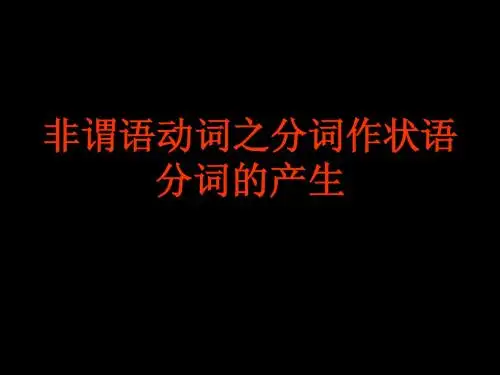
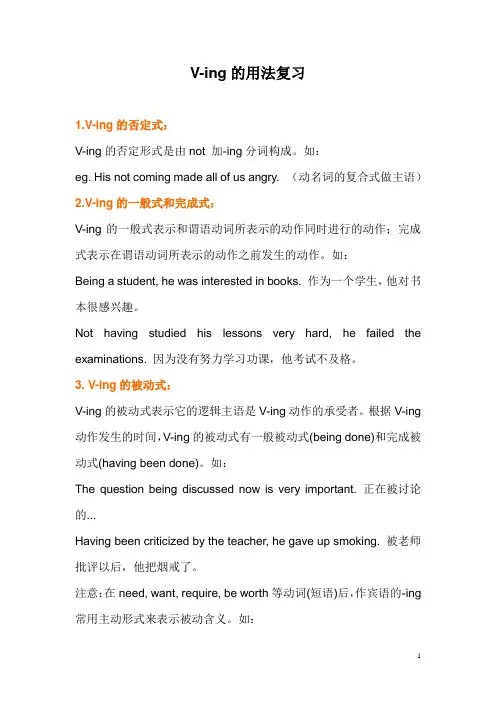
V-ing的用法复习1.V-ing的否定式:V-ing的否定形式是由not 加-ing分词构成。
如:eg. His not coming made all of us angry. (动名词的复合式做主语)2.V-ing的一般式和完成式:V-ing的一般式表示和谓语动词所表示的动作同时进行的动作;完成式表示在谓语动词所表示的动作之前发生的动作。
如:Being a student, he was interested in books. 作为一个学生,他对书本很感兴趣。
Not having studied his lessons very hard, he failed the examinations. 因为没有努力学习功课,他考试不及格。
3. V-ing的被动式:V-ing的被动式表示它的逻辑主语是V-ing动作的承受者。
根据V-ing 动作发生的时间,V-ing的被动式有一般被动式(being done)和完成被动式(having been done)。
如:The question being discussed now is very important. 正在被讨论的...Having been criticized by the teacher, he gave up smoking. 被老师批评以后,他把烟戒了。
注意:在need, want, require, be worth等动词(短语)后,作宾语的-ing 常用主动形式来表示被动含义。
如:Your shoes need cleaning. = Your shoes need to be cleaned. This book is well worth reading.4.V-ing的语法作用V-ing分词一方面具有动词的性质,另一方面也相当于一个名词或形容词、副词,在句中可以作主语、表语、宾语、定语、状语和补语等。
1)V–ing(短语)作主语:Saying is easier than doing. 说比做容易。

Unit 5 Grammar :Revising the –ing form.♥学习目标:(1) 动词-ing形式作状语可表示:时间、原因、条件、让步、伴随等。
(2) 动词-ing形式的完成式:主动:Having + p.p. …, 主语+ 谓语被动:(Having been) + p.p. …, 主语+ 谓语【重点难点】灵活应用V-ing作状语一.第一关:判断Ving 在句中的成分1.The child ran out of the room, laughing and talking.2.Seeing nobody at home, Linda decided to leave them a note.3.If having more time, we can do it better.4.Though living near her house,I seldom see her .5.The child fell, striking his head.分词作状语表示时间、_____\______\____\______\______,其逻辑主语通常与句子的主语______,Ving表示的动作与主语之间含有逻辑上的_____关系。
第二关:把V-ing改成状语从句做状语ing out of my house, I saw the volcano erupting.2.Waking up in the middle of the might, She saw her room was as bright as day.3. He sat on the sofa, watching TV.(=He sat on the sofa ____ ______TV.)4. Though having little money, he always helped the poor.(=_____ ____ ________little money, he always helped the poor.5.Being too fat, he couldn’t join the army.6.Having more time, I will do the work much better.归纳:V-ing做状语,其前往往可以加-------------------------------------等连词,构成“连词+V-ing”结构。
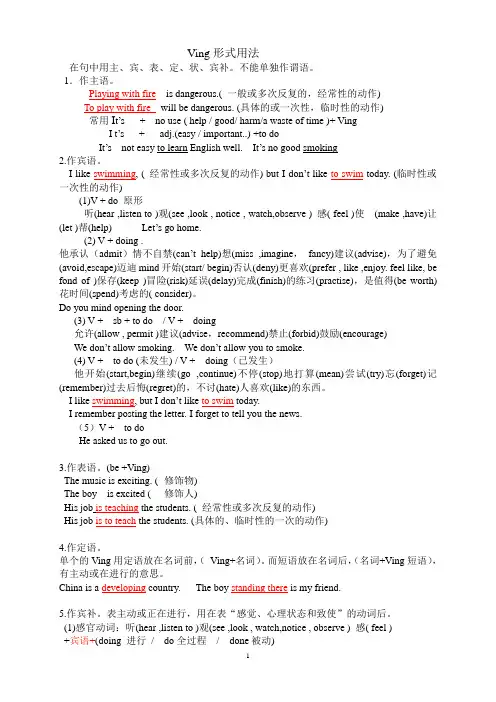
Ving形式用法在句中用主、宾、表、定、状、宾补。
不能单独作谓语。
1.作主语。
Playing with fire is dangerous.( 一般或多次反复的,经常性的动作)To play with fire will be dangerous. (具体的或一次性,临时性的动作)常用I t’s + no use ( help / good/ harm/a waste of time )+ VingI t’s + adj.(easy / important..) +to doIt’s not easy to learn English well. It’s no good smoking2.作宾语。
I like swimming, ( 经常性或多次反复的动作) but I don’t like to swim today. (临时性或一次性的动作)(1)V + do 原形听(hear ,listen to )观(see ,look , notice , watch,observe ) 感( feel )使(make ,have)让(let )帮(help) Let’s go home.(2) V + doing .他承认(admit)情不自禁(can’t help)想(miss ,imagine,fancy)建议(advise),为了避免(avoid,escape)迈迪mind开始(start/ begin)否认(deny)更喜欢(prefer , like ,enjoy. feel like, be fond of )保存(keep )冒险(risk)延误(delay)完成(finish)的练习(practise),是值得(be worth)花时间(spend)考虑的( consider)。
Do you mind opening the door.(3) V + sb + to do / V + doing允许(allow , permit )建议(advise,recommend)禁止(forbid)鼓励(encourage)We don’t allow smoking. We don’t allow you to smoke.(4) V + to do (未发生) / V + doing(已发生)他开始(start,begin)继续(go ,continue)不停(stop)地打算(mean)尝试(try)忘(forget)记(remember)过去后悔(regret)的,不讨(hate)人喜欢(like)的东西。

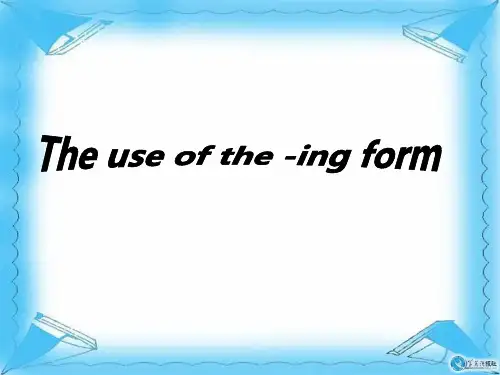
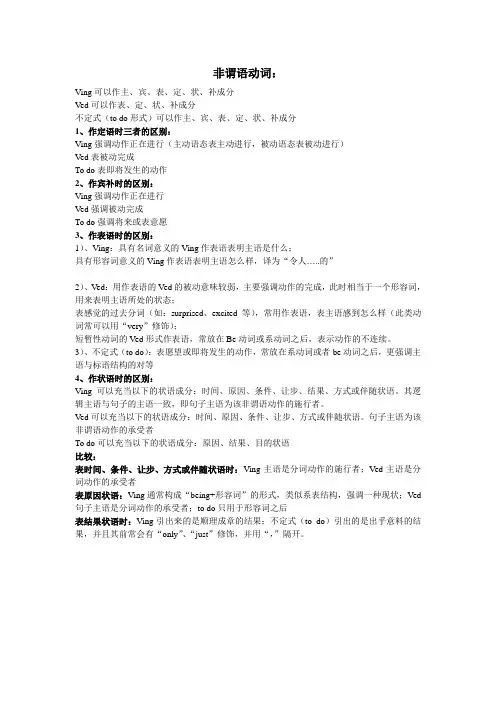
非谓语动词:Ving可以作主、宾、表、定、状、补成分Ved可以作表、定、状、补成分不定式(to do形式)可以作主、宾、表、定、状、补成分1、作定语时三者的区别:Ving强调动作正在进行(主动语态表主动进行,被动语态表被动进行)Ved表被动完成To do表即将发生的动作2、作宾补时的区别:Ving强调动作正在进行Ved强调被动完成To do强调将来或表意愿3、作表语时的区别:1)、Ving:具有名词意义的Ving作表语表明主语是什么;具有形容词意义的Ving作表语表明主语怎么样,译为“令人…..的”2)、Ved:用作表语的Ved的被动意味较弱,主要强调动作的完成,此时相当于一个形容词,用来表明主语所处的状态;表感觉的过去分词(如:surprised、excited等),常用作表语,表主语感到怎么样(此类动词常可以用“very”修饰);短暂性动词的Ved形式作表语,常放在Be动词或系动词之后,表示动作的不连续。
3)、不定式(to do):表愿望或即将发生的动作,常放在系动词或者be动词之后,更强调主语与标语结构的对等4、作状语时的区别:Ving可以充当以下的状语成分:时间、原因、条件、让步、结果、方式或伴随状语。
其逻辑主语与句子的主语一致,即句子主语为该非谓语动作的施行者。
Ved可以充当以下的状语成分:时间、原因、条件、让步、方式或伴随状语。
句子主语为该非谓语动作的承受者To do可以充当以下的状语成分:原因、结果、目的状语比较:表时间、条件、让步、方式或伴随状语时:Ving-主语是分词动作的施行者;Ved-主语是分词动作的承受者表原因状语:Ving通常构成“being+形容词”的形式,类似系表结构,强调一种现状;Ved 句子主语是分词动作的承受者;to do只用于形容词之后表结果状语时:Ving引出来的是顺理成章的结果;不定式(to do)引出的是出乎意料的结果,并且其前常会有“only”、“just”修饰,并用“,”隔开。
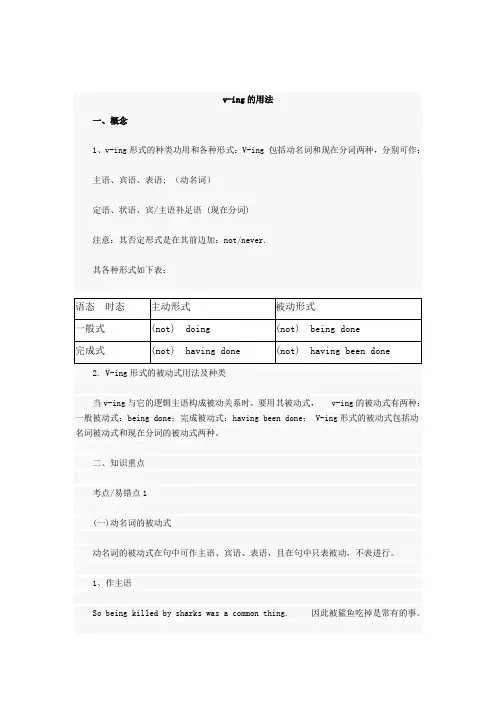
v-ing的用法一、概念1、v-ing形式的种类功用和各种形式:V-ing 包括动名词和现在分词两种,分别可作:主语、宾语、表语; (动名词)定语、状语、宾/主语补足语 (现在分词)注意:其否定形式是在其前边加:not/never.其各种形式如下表:Being laughed at in public is a terrible thing.在公共场合下被嘲笑是件可怕的事。
Being exposed to the sun does harm to health.暴漏在阳光下对身体有害。
The president's being killed led to serious consequences.总统被杀导致了严重后果。
2、作宾语V-ing形式的被动式既可作动词的宾语,也可作介词的宾语。
He was afraid of _________________ (abandon) by us.He did it without ______ _____ (ask)You can't eat anything before _____________(operate on)I remember having be en told the story.3、作表语What worried the child most was his not being allowed to visit his mother i n the hospital.使孩子最为担心的是他不被允许到医院看母亲。
What I hate most is ________________ (laugh at)The problem is for from _______________ (settle)注意:①动名词的被动式作主语和表语时,常用其一般式(being done),不习惯用完成式;但作宾语时,若其动作发生谓语动词之前或强调动作已经发生,可用其完成式(hav ing been done)。
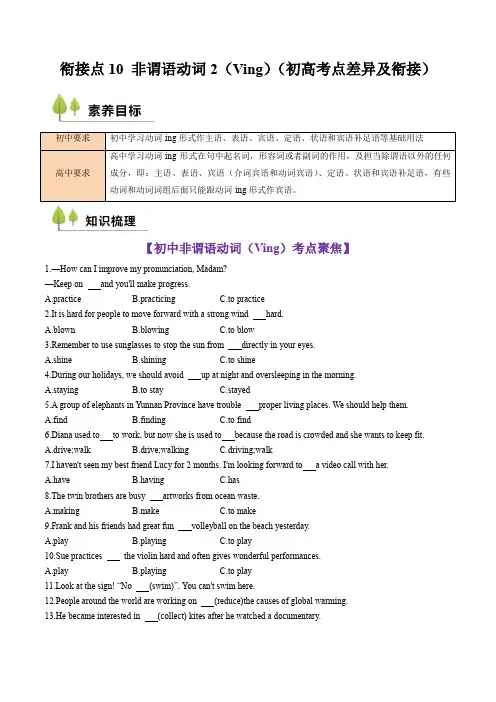
衔接点10 非谓语动词2(Ving)(初高考点差异及衔接)初中学习动词-ing形式作主语、表语、宾语、定语、状语和宾语补足语等基础用法初中要求1.—How can I improve my pronunciation, Madam?—Keep on and you'll make progress.A.practiceB.practicingC.to practice2.It is hard for people to move forward with a strong wind hard.A.blownB.blowingC.to blow3.Remember to use sunglasses to stop the sun from directly in your eyes.A.shineB.shiningC.to shine4.During our holidays, we should avoid up at night and oversleeping in the morning.A.stayingB.to stayC.stayed5.A group of elephants in Yunnan Province have trouble proper living places. We should help them.A.findB.findingC.to find6.Diana used to to work, but now she is used to because the road is crowded and she wants to keep fit.A.drive;walkB.drive;walkingC.driving;walk7.I haven't seen my best friend Lucy for 2 months. I'm looking forward to a video call with her.A.haveB.havingC.has8.The twin brothers are busy artworks from ocean waste.A.makingB.makeC.to make9.Frank and his friends had great fun volleyball on the beach yesterday.A.playB.playingC.to play10.Sue practices the violin hard and often gives wonderful performances.A.playB.playingC.to play11.Look at the sign! “No (swim)”. You can't swim here.12.People around the world are working on (reduce)the causes of global warming.13.He became interested in (collect) kites after he watched a documentary.【高中非谓语动词(Ving)考点聚焦】考纲解读动词-ing形式也是一种非谓语动词,由“动词原形+ing”构成,因此具有动词的性质,有时也相当于一个名词、形容词或副词。


本⽂收集了1989~2001年⼤学英语四级考试试卷中V-ing⽤法的考题共20题,对V-ing的语法作⽤进⾏归类性分析。
V-ing形式包括传统语法所指"现在分词"和"动名词"两种结构,在句中可⽤作主语、状语、定语、宾语和补⾜语等成分。
⽂章着重分析了现在分词作状语、宾语补⾜语、后置定语以及取代从句的⽤法,并对动名词的⽤法也作了分析。
V-ing形式包括传统语法所指"现在分词"和"动名词"两种结构。
V-ing现在分词由动词原形+ing构成,有完成体和被动态,但不体现动作或过程的时间关系,它的时间关系要借助于主句动词的"时"的形式来表⽰,除去动词be和have以外,其他助动词(包括所有情态助动词)都没有V-ing分词形式。
主动词,不论是及物动词还是不及物动词,动态动词还是状态动词,都能构成V-ing形式。
⼀、V-ing⽤作现在分词1、V-ing分词短语不仅可以⽤作形容词,对名词提供更多的情况,⽽且还可以⽤来进⼀步说明动词的动作或整个句⼦所表达的概念。
这样使⽤时,它们与副词相似。
The computer works fast _____ data at the speed of light.(1993.1/43)A)have handledB)handlingC)handledD)handles答案B)。
计算机⼯作速度快,以光的速度处理数据。
2、正常情况下,V-ing分词短语的主语和主句的主语是⼀致的。
当V-ing分词短语作状语时,其逻辑主语通常是主句的主语。
This program will examine the writer's books in detail, _____ an introduction to her?life.(1994.1/45)A)followingB)being followedC)having followedD)to be followed答案A)。
ving形式的基本用法首先,ving形式可以用作动词的主语。
在句子中,如果我们想强调一个动作或者状态是主要的,我们可以使用ving形式作为主语。
例如:1. Singing makes me happy.(唱歌让我开心。
)2. Swimming is good exercise.(游泳是很好的锻炼。
)3. Dancing requires practice.(跳舞需要练习。
)在这些句子中,sing、swim、dance都是动词的主语,它们使用ing形式作为名词来描述主要的动作或者状态。
除此之外,ving形式也可以用作动词的宾语。
在这种情况下,它可以用来描述动作的持续性或者背景。
例如:1. I enjoy reading books.(我喜欢看书。
)2. They dislike swimming in cold water.(他们不喜欢在冷水中游泳。
)3. She regrets telling him the truth.(她后悔告诉了他真相。
)在这些例子中,reading、swimming、telling都是动词的宾语,它们使用ing形式来描述动作的特征。
此外,ving形式也可以用作形容词。
它描述或者修饰名词,表示具有其中一种特定的特征或者状态。
例如:1. The running water was so refreshing.(流动的水非常清凉。
)2. I saw a stunning sunset yesterday.(昨天我看到了一场令人惊叹的日落。
)3. The crying baby needs to be fed.(哭闹的婴儿需要喂食。
)在这些例句中,running、stunning、crying都是ving形式作为形容词来修饰名词。
此外,ving形式还可以用作介词的宾语。
它可以表示一种同时发生的动作。
例如:1. He is good at taking care of children.(他擅长照顾孩子。
1 v-ing形式作状语 v-ing形式作状语时,用于修饰某动词或整个句子,所表示的动作与句子主语构成逻辑上的主谓关系。v-ing形式作状语时,可以单独使用,也可以在其前加上when,while,after,if,unless,although,though等连词,表示时间、原因、条件、让步、结果、伴随、方式等。
1. 作时间状语 Hearing this news, she got frightened. 听到这个消息,她感到害怕。 Looking out of the window, I saw some children playing football. Turning around , he saw a tiger running up. 2. 作结果状语 The boy ran even faster,reaching the school out of breath. 那个男孩跑得更快了,到达学校时累得上气不接下气了。 The child slipped and fell, hitting his head against the door. Her husband died, leaving her four children. They fired, killing many people in the street. 3. 作伴随状语 He stood by the window, watching people passing by his window. He came running. She stood waiting for a bus. He sat there reading a book. The students ran out of the classroom, talking and laughing. 4. 作原因状语 Being a student, I must study hard. 作为一名学生,我必须努力学习。 Seeing nobody at home, he left them a note. Not knowing his telephone number, I couldn’t get in touch with him. 5. 作让步状语 Having lived here for four years, I am not familiar with my neighbors. 虽然我在这儿住了四年,我对邻居们都还不熟悉。 Working or reading, she always did her best. 不管是工作还是阅读,她总是竭尽全力。 Not being a rich man himself, he helped the poor generously. 尽管他自己不算富裕,他却是慷慨的帮助穷人。 6. 作条件状语 Heating water, we can change it into vapour. 把水加热,我们可以将其变为水蒸汽。 Working in his small room, he made three pairs of shoes every day. 在他的小房间里工作,每天做三双鞋。 Using your head, you’ll find a good way. Working hard, you’ll surely succeed. 7. 作目的状语 He stayed up late into the night, attempting to pass the entrance exam. 他晚上睡得很晚,想通过考试。
注意: 一、V-ing 的时态和语态。 2
下表以动词do为例说明现在分词的时态和语态的不同变化形式及其否定式的构成: 1.现在分词的一般式表示该动作在与谓语动作同时发生或在谓语动作之后发生,完成式则表示该动作发生在谓语动作之前,在句中只能作状语表示时间和原因。如: Standing on top of the hill, you can see as far as the seaside. (分词动作与谓语动作同时发生) The fish can eat a person in two minutes, leaving only bones. (分词动作在谓语动作之后发生) Having finished his homework, the boy went out to play football. (分词动作在谓语动作之前发生) Having turned off the TV set, he bagan to do his homework.
2. 现在分词的主动式表示动作是由句子主语发出,而被动式表明主语承受该动作。如: Being noticed by so many people, she felt nervous, not knowing what to say. Being helped by the teacher, she will learn English well. Having been shown the lab, we were taken to see the library. Having been translated into many languages, the book was widely read all over the world.
3. 现在分词的否定式是在一般式和完成式的前面加not (never)。注意完成式的否定式应将not(never)加在have前。如: Not having heard from her son for a long time, the mother worried a great deal. Not having been washed in the correct way, the coat has faded.
二、现在分词可以与when, while, if, though等连词使用。如: When doing your homework, you mustn't listen to the music. Though having been warned many times, she got to school late again. While reading the book, she nodded from time to time.
三、v-ing形式作状语时,它的逻辑主语必须与主句的主语是一致的。 Rushing into the dining-room, supper was waiting for me.(X) Rushing into the dining-room, I found supper was waiting for me. While visiting a strange city, a guide-book is very helpful.(X) While visiting a strange city, you may find a guide-book very helpful.
四、当现在分词的逻辑主语不是句中主语时,可以带有自己的主语--名词或代词主格。这样的结构属于独立主格结构,有时前面还可加介词with构成复合结构。 3
Spring coming on, the trees turned green. Her mother being ill, she had to look after her at home. Time permitting, we’ll visit the Great Wall. He guiding the blind man, they walked slowly across the street. Weather permitting, we will go out for a picnic next Sunday. With so many people looking at her, the girl felt nervous.
五. 固定结构:v-ing形式可以作独立成分,表示说话人的态度或看问题的角度。如: Judging from his appearance, he must be a very healthy boy. Generally speaking, boys are more active than girls in sports. Judging from his appearance, he must be very rich. Generally speaking, his answer is right. Considering everything, they did a good job.
六、V-ing形式作状语时,可以用相应的状语从句替代,从句谓语必须用主动语态。 Seeing the picture, I couldn’t help thinking of the days in America.(=When I saw the picture, I…) While reading the book, she nodded from time to time. (= While she was reading the book, she nodded from time to time.) Being a student, I must study hard. (= As I am a student, I must study hard.) Not knowing how to do it, he asked the teacher for help. (= As he didn’t know how to do it, he asked the teacher for help.)由于不知道如何干,他请老师帮助。 Meeting anywhere else, we wouldn’t have recognized each other. (=If we had met anywhere else, we wouldn’t have recognized each other.)如果是在别处见面,我们彼此会认不出来的。
边学边练: 1. Don’t sit there _______ nothing at all. Come and help me with this table. A. do B. to do C. doing D. and doing 2. The snow storm left, _______ a lot of damage to southern China. A. caused B. to have caused C. to cause D. having caused 3. He glanced over at her, _______ that though she was tiny, she seemed very well put together. A. noting B. noted C. to note D. having noted 4. _______ in a white uniform,he looks more like a cook than a doctor. A. Dressed B. To dress C. Dressing D. Having dressed 5. The manager, _______ it clear to us that he didn’t agree with us ,left the meeting room. A. who has made B. having made C. made D. making 翻译下列句子。 1. 如果时间允许,我会去看望我的老师。 2. 我们发现他躺在床上,听着MP3。 3. 老师把三种不同的液体混合在一起,结果发现混合物呈现出红色。 4. 通过讨论,我们找到了解决这道数学题的方法。